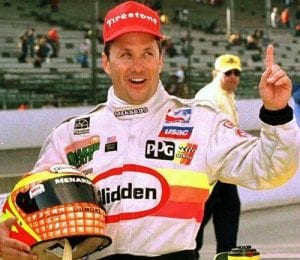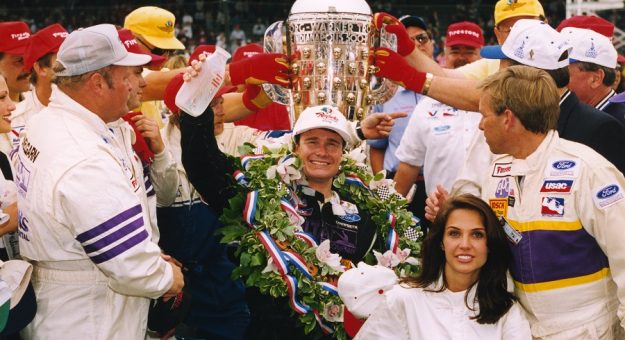After the hectic activity of a weekend of qualifying, practice days fell into a mundane routine of the unqualified seeking speed and the qualified working on race setups. On May 17, Brayton’s backup car punctured a tire while he ran fuel tests. It pounded the turn-one concrete wall and the driver died instantly.
His death cast a pall over the entire Indy car community. The ugly politics paled in comparison and a temporary truce ensued as the warring sides united for Brayton’s funeral on May 22.
Menard expressed the impact of Brayton’s loss.

“We lost a great friend, a great husband, a great father, and a great competitor,” lamented Menard. “Scotty just loved this place (Indianapolis). He loved running fast here, loved the competition. He was so proud of the fact he had the pole. He worked hard for that. Scotty had a perfect car, a perfect day and a perfect track and it reached out and bit him. It reminds you that this is a very serious business that we’re about.”
Brayton’s loss left Menard with a difficult decision. A pole winner had never died prior to the race, so what to do with Brayton’s car? Honor him by running it, or by letting it sit? Menard opted to race with veteran Danny Ongais behind the wheel.
Ongais started in the last row and finished seventh. Stewart inherited the pole. On the pace laps, however, Ongais hung well back to provide fans all around the speedway a chance to pay tribute to Brayton.
While at the front of the field, Stewart remained in his second spot leaving Brayton’s position open, reminiscent of a military missing-man flyover.
At the green flag, Stewart shot into the lead as the 33 starters funneled safely through turn one in a smooth, spectacular display of sight and sound unique to the start of an Indianapolis 500.
Meanwhile, at MIS, the start of the U.S. 500 was anything but smooth. As the field accelerated to the green flag, arranged in rows of three to duplicate Indy, two cars tangled and gathered up a dozen cars in the process.
Back at Indianapolis, Stewart appeared the one to beat. He led the first 31 laps and another 13 circuits of the 2.5-mile track before he dropped out after 82 laps.
Outspoken even then, when asked about his problem Stewart shouted, “Ask USAC, ask USAC. It was one of USAC’s junk pop-off valves!”
At Stewart’s exit, the race settled into a battle among Lazier, Davy Jones, and Alessandro Zampedri. Lazier was the class of that trio.
With former sprint car standout Lee Kunzman, managing the Hemelgarn team, Lazier had displayed impressive speed as early as the spring tire tests at Phoenix Raceway, where he was quicker than even the CART regulars who also tested there.
Lazier arrived at Indy with a severely injured back from a crash during the Phoenix IRL race and hobbled around with a cane while wearing a back brace. But he was quietly quick all month and qualified fifth.
He raced cradled in a seat specifically designed to support his painful back and was in the hunt, running with the lead group all day. Then, when Lazier went around Jones on lap 192, the race was over. He took the checkered flag as the winner of the first of a dozen politically fractured 500s.
Respected by his peers, those on both sides of the split were happy for him. Jimmy Vasser, who won the U.S. 500 at Michigan, said, “I was glad Buddy won. At least he was one of us.”
No one really wanted what took place 25 years ago this May to occur. Bobby Rahal, speaking to ABC Sports, summarized it best at the time. “Let’s face it: Michigan was a good race with a good crowd, but it wasn’t Indy. Hopefully, this won’t last long.”
It lasted too long.
